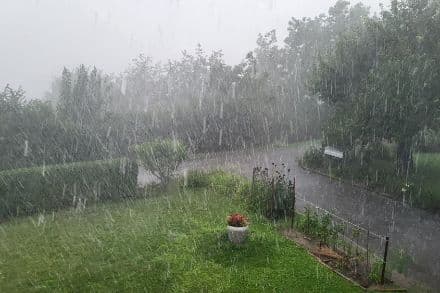Decoding the Deluge: Why Germany's Skies Are Unleashing Historic Rainfall
Germany braces for historic rainfall. Discover the storm's unprecedented scale, its hidden dangers, and how regions are mobilizing for this extreme weather event.
The Unprecedented Downpour: Scale and Scope of the Warning
The has just issued its highest-level severe weather warning, Stufe 4, for significant portions of the country. This isn't just another summer storm; we're talking about an unprecedented deluge. While a brief but intense thunderstorm earlier saw grappling with flooded streets and downed trees, the primary focus of this escalated warning is on Germany's northeast. Regions like , especially around , , , and the , are bracing for prolonged, heavy rainfall expected to last until Tuesday midday.
The sheer volume of water anticipated is staggering. The DWD forecasts between 80 and 140 liters per square meter within a mere twelve hours. To put that into perspective, a DWD spokesperson highlighted that this amount is comparable to the catastrophic rainfall that triggered the . For the region, such a downpour would be roughly double its typical monthly rainfall for July. This "huge swell," as one spokesperson described it, is set to arrive overnight. However, there's a crucial distinction: unlike the mountainous terrain of the Ahrtal, the flatter landscapes near the are expected to facilitate better water runoff, potentially mitigating the worst effects of flash flooding. Nevertheless, the scale of this meteorological event remains truly exceptional.
Beyond the Rain: Real-World Impacts and Hidden Dangers
While the DWD's warning paints a stark picture of the impending rainfall, the real-world implications extend far beyond mere wet streets. The immediate aftermath of the initial storm in Mainz offered a glimpse: submerged roads and uprooted trees underscore the disruptive power of even "short but severe" weather events. As the focus shifts to the northeast, local authorities in areas like Rostock and the Mecklenburg Lake District are preparing for widespread localized flooding and basements filling with water, a common yet devastating consequence for homeowners.
But the dangers aren't always immediately visible. Beyond the obvious property damage, such extreme weather events can overwhelm urban drainage systems, leading to prolonged standing water that disrupts transport and daily life. The threat of power outages looms large, as does the potential for trees to weaken and fall, posing risks to infrastructure and public safety. In , the preventative cancellation of the at the Waldbühne serves as a powerful reminder of how these weather warnings ripple through society, affecting everything from major cultural events to individual plans. The psychological toll on residents, particularly those who remember past flood disasters, also cannot be underestimated, adding a layer of hidden anxiety to the visible chaos.
Frontline Preparedness: How Regions Are Responding
In the face of such a formidable weather threat, regions across Germany are activating comprehensive preparedness strategies, demonstrating a proactive stance honed by past experiences. In Mecklenburg-Vorpommern, local districts are already well into their preparations for the anticipated extreme weather. This includes reinforcing critical control centers in key areas like Rostock, Vorpommern-Greifswald, and the Mecklenburg Lake District, ensuring that emergency services are adequately staffed and equipped to handle the expected surge in calls for help.
Communication is proving vital. The district of Vorpommern-Greifswald has gone a step further, advising its residents to take preventative flood protection measures where possible, empowering individuals to safeguard their properties. The city of Rostock exemplifies modern alert systems, utilizing its dedicated warning app to keep the population informed in real-time about the unfolding situation and necessary precautions. These regional responses, from bolstering emergency infrastructure to direct public engagement, highlight a collective effort to minimize the potential impact of the "huge swell." It's a testament to learning from history, like the Ahrtal tragedy, by prioritizing early warnings, robust coordination, and community involvement to navigate the challenges posed by an increasingly unpredictable climate.
Related Articles

The Coming Deluge: Germany's Highest Storm Alert and the Battle for Resilience

The Coming Deluge: Germany's Highest Storm Alert and the Battle for Resilience

Alpine Fury Unleashed: Navigating Switzerland's Extreme Weather Resilience

Alpine Fury Unleashed: Navigating Switzerland's Extreme Weather Resilience

Switzerland's Wet Awakening: Unpacking a Weekend of Torrential Alpine Fury

Switzerland's Wet Awakening: Unpacking a Weekend of Torrential Alpine Fury

Summer Skies Unfiltered: Mastering the Art of Local Weather Wisdom
